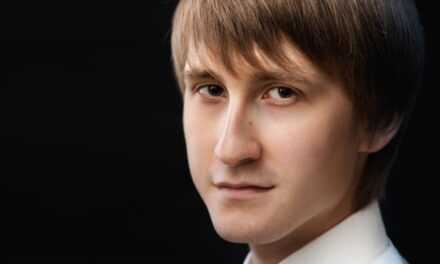Joseph Joachim (1831-1907) was one of the most influential violinists of the 19th century. He was also a romantic, and he adopted as his personal motto the phrase Frei aber Einsam (“free but alone” or “free but lonely”). That motto gave rise to one of the more unusual works in the chamber music literature: a violin sonata penned by three different composers.
Robert Schumann (1810-1856), Johannes Brahms (1833-1897), and Schumann’s student Albert Dietrich (1829-1908) collaborated to write the “F.A.E. Sonata” for Joachim on his visit to Dusseldorf in 1853. Schumann penned this inscription in the score: “F.A.E.: In expectation of the arrival of their revered and beloved friend, Joseph Joachim, this sonata was written by R.S., J.B., A.D.” When the violinist (accompanied by Robert’s wife, Clara Wieck Schumann) performed the work, he apparently had no trouble identifying who wrote each movement. The sonata was not published until 1935.
Dmitri Sitkovetsky, Music Director of the Greensboro Symphony , served as violinist with pianist Julia Zilberquit at the keyboard. Ms. Zilberquit was in town as the guest artist in the GSO’s Masterwork series, playing the “Jewish Rhapsody” by Sergei Slonimsky, reviewed here.
All four movements of the violin sonata make use of the motto, F-A-E, although in very different guises. The opening Allegro movement by Dietrich is lovely: expressive with equal sharing of material between the violin and piano. The Romanze, by Schumann, is a short movement that features a soaring violin line with a more active piano accompaniment. The Scherzo was written by Brahms, who had already penned a couple of scherzos to acclaim in his piano sonatas. Fiery passages bookend a slower moving, lyric middle section. The fast sections contain the rhythmic excitement and ambiguity (groups of twos alternating with groups of threes), a hallmark of the composer’s style. The Finale (by Schumann) is somewhat humorous and fractured.
The two performers were equal partners in the undertaking. Sitkovetsky took the lead when he had important material, but always backing off when Zilberquit had the main melody. Balance was good, and the solid performance gave the large crowd the opportunity to consider this chamber music oddity.
The first half of the evening was devoted to two works by Vivaldi (1678-1741). As Sitkovetsky explained, the two pieces were not usual chamber pieces, because Vivaldi did not write any keyboard concertos. Thus, Bach arranged a couple of his violin concertos for organ, and then Zilberquit arranged those versions for piano and string quartet, thereby “enlarging the repertoire,” according to Sitkovetsky.
Joining pianist Zilberquit were GSO players Stephanie Ezerman and Wendy Rawls, violins, Maureen Michels, viola, and Gina Pezzoli, cello. The Concerto Grosso in D Minor, Op. 3, No. 11, is in three movements, a fast-slow-fast arrangement. The first movement is in three parts, also fast-slow-fast. The Concerto Grosso in A Minor, Op. 3, No. 8, is also in three movements.
Intonation throughout was pretty good, although not always perfect. Ms. Zilberquit provided an aggressive piano part, sometimes overpowering the string players. The playing was animated and tender by turns, with give-and-take between the strings as well as between strings and piano. The first movement of No. 11 was taken at such a breakneck speed that sometimes it seemed as if the players were trying to keep up with each other. The fast tempo did, however, provide lots of energy.











